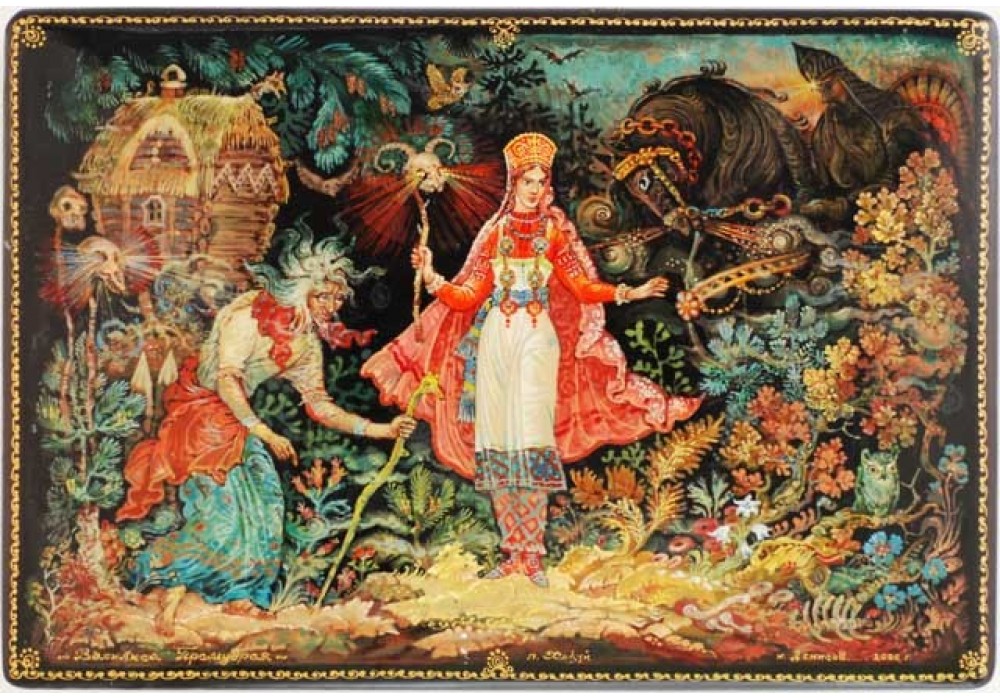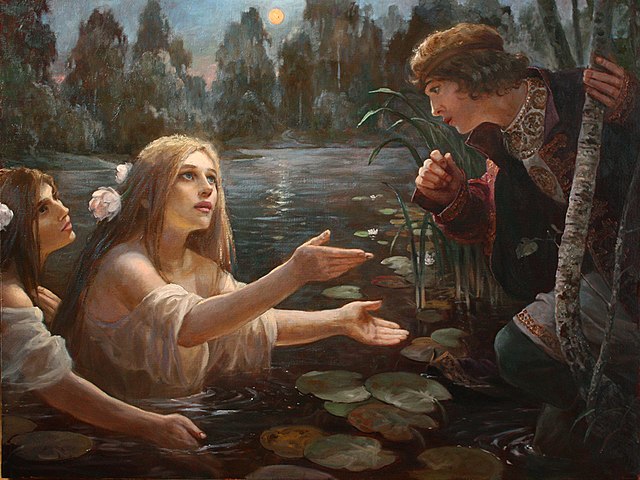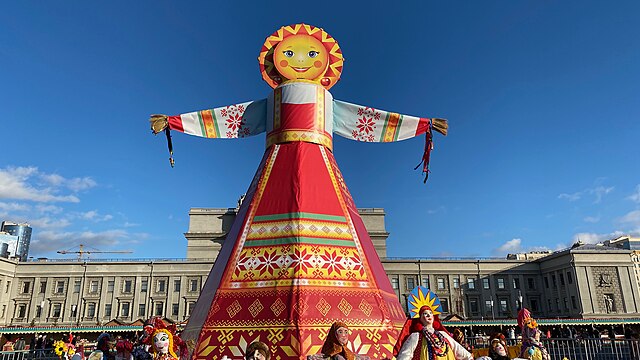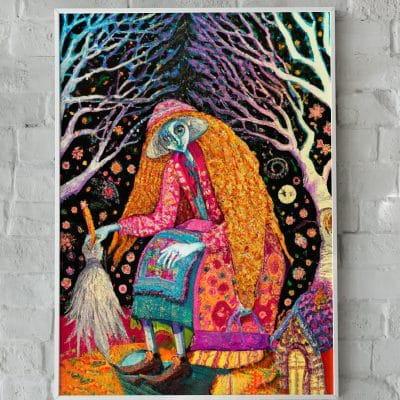Baba Yaga

Dive into the enigmatic world of Baba Yaga, Slavic folklore’s quintessential enchantress. Picture this: a hut perched on chicken legs, hidden deep within the forest’s embrace. Baba Yaga herself? A paradox wrapped in a riddle, veering wildly between guardian of arcane secrets and the shadow lurking in every child’s nightmares. She navigates the skies in a mortar, steering with a pestle, the embodiment of ancient magic and untamed wilderness.
Baba Yaga stands as folklore’s original rebel, defying any attempt to pigeonhole her. In tales like “Vasilissa the Beautiful,” she flings down gauntlets of impossible challenges, not out of malice, but as invitations to transformation. Facing Baba Yaga is akin to confronting one’s deepest fears, only to emerge empowered, with newfound clarity. Her presence in these narratives isn’t just for thrills; it’s a masterclass in the art of becoming, teaching that sometimes, the path to enlightenment goes through the witch’s forest.
Inspired? Add some Baba Yaga energy to your home…
Vasilisa the Beautiful

Embark on the saga of Vasilisa the Beautiful, whose narrative weaves through the shadows of adversity, lit by the faint glow of a magical doll. Bestowed by her dying mother, this doll becomes Vasilisa’s beacon, guiding her through tasks no mortal could bear alone. Sent into the gnarled embrace of the forest to seek light from Baba Yaga, Vasilisa’s story is one of courage facing the unknown. Her tale doesn’t just shimmer with the magic of survival; it radiates the triumph of purity and wisdom over malice. In the end, Vasilisa’s journey from the depths of servitude to the heights of royal recognition is a testament to her inner strength, illuminated by the very light she sought, transforming her fate into one of regal magnificence.
Vasilisa the Wise

Vasilisa the Wise isn’t just another pretty face in folklore; she’s the brains of the operation! While Vasilisa the Beautiful wins hearts with her kindness and, well, beauty, Vasilisa the Wise dazzles with her brainpower. Whether she’s outsmarting the Sea Tsar with a cunning plan, giving the prince a cheat sheet for magical tasks, or cleverly navigating her way through trials as the enigmatic Frog Princess (a role she plays in a Ukrainian variant of this tale), she shows that intellect and wit can triumph over any obstacle. She’s the ultimate problem solver, proving that brains beat brawn every time in the enchanting world of fairy tales.

Kikimora
Kikimora is a house spirit of Slavic lore. Picture her as the yin to the male house spirit Domovoy’s yang, weaving her magic behind the scenes. Whether she’s bringing good vibes or a bit of mischief to your doorstep hinges on how you run the ship at home. Cozying up behind the stove or chilling in the cellar, she’s known to stir up a symphony of mouse-like sounds when she’s on the prowl for a snack. And for those nights when you’re caught in a half-awake daze, unable to move? You’ve got the Kikimory to thank for that first brush with sleep paralysis, at least according to old Russian tales.
Rusalka

Rusalki, the cheeky water nymphs of Slavic lore, are not your garden-variety mermaids. These spirited beings, once thought to be the souls of unfortunate women, have turned their afterlives into an endless water party. By day, they’re elusive, blending with the ripples of rivers and lakes, but by night, they’re all about luring mortals into splashy shenanigans with a charm only a Rusalka can muster. While they might have a mischievous streak, they’re also guardians of waterways, ensuring nature’s bounty remains lush and lively. So, if you ever catch a whisper of laughter over the water, just remember—it’s the Rusalki, hosting the ultimate underwater gala, where the only entry ticket is a love for the mysterious depths they call home.
Lady Maslenitsa

Lady Maslenitsa reigns supreme as the straw-stuffed queen of the Maslenitsa festival, a week where calories don’t count and winter gets its eviction notice. She’s not just any ordinary effigy; think of her as winter’s most fashionable scapegoat, decked out in her finest garb, overseeing a riot of pancakes, dances, and sledging shenanigans. As the festivities reach their crescendo, this lady of the straw takes one for the team in a fiery blaze of glory. Her dramatic exit in a bonfire is not just a spectacle but a communal high-five, bidding adieu to the frosty chill and rolling out the red carpet for spring. It’s a time-honored way to say, “See ya, winter! Don’t let the door hit you on the way out!” With Lady Maslenitsa’s departure, she leaves behind the promise of warmer days, sprouting buds, and the unbeatable feeling of community spirit. It’s a humorous nod to the cyclical drama of the seasons, where everyone gets to chuckle, shrug off their winter blues, and leapfrog into spring.
Mavka

Step into the dense foliage of Ukrainian myths and encounter the Mavka, a spirit of the forest that embodies the untamed beauty and mystery of nature. Mavkas are guardians of the woodland realm, their stories woven with threads of tragic love and the eternal cycle of life and death. They challenge us to look beyond the veil of the visible world, to the heart of the wild where love and loss dance in eternal embrace. In their narrative, we find a profound connection to the earth, a call to preserve its beauty and heed its wisdom.
Poludnitsa

Poludnitsa, or the Noonday Witch, is Eastern Europe’s sun-soaked specter with a flair for drama and a strict schedule. This mythical figure is all about that midday menace, appearing when the sun is at its zenith to remind folks that siesta time is not just a good idea—it’s practically a survival strategy. Legend has it that Poludnitsa floats through the fields, shimmering in the heatwaves, part guardian of the grain and part arbiter of agricultural punctuality. She’s known to quiz passersby or field workers with riddles or tasks, and let’s just say, you really don’t want to get those wrong. Despite her daunting job description, there’s a whimsical side to her; she’s essentially nature’s way of saying, “Take a break, or else!” So, if you ever find yourself wandering the countryside around noon, maybe pack a sandwich, find a nice shady spot, and whatever you do, don’t forget to respect the lady of the hour—or in this case, the witch of the midday sun.





